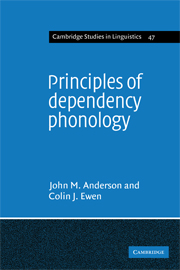6 - The articulatory gesture
Published online by Cambridge University Press: 04 August 2010
Summary
In this chapter we consider the representations of the second of the two gestures discussed in §II.3, the articulatory gesture. Here again, we are concerned with two sub-gestures, the locational and the oro-nasal, but, clearly, the bulk of the discussion will deal with what is traditionally referred to as place of articulation for consonants, and with the location of vowels in articulatory space, i.e. with purely locational matters.
It seems appropriate to deal with vowels and consonants in separate sections, although, as we shall see, the representations for the two are not entirely distinct.
Vowels: the basic vocalic components
In chapter 1 we discussed in some detail the problems associated with systems of phonological representation which characterised vowels by means of binary features (SPE; Wang 1968; etc.), with or without the various extensions to the standard SPE system, or by means of n-ary or scalar features (Contreras 1969; Ladefoged 1971; Saltarelli 1973), and we do not intend to repeat the arguments which led us to propose a set of single-valued vowel components in place of any version of binary or multi-valued distinctive feature theory. Our intention in this section is to explore further the precise nature of these components, and to survey some of the implications of the particular set which we will establish.
- Type
- Chapter
- Information
- Principles of Dependency Phonology , pp. 206 - 252Publisher: Cambridge University PressPrint publication year: 1987



